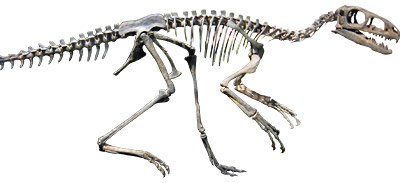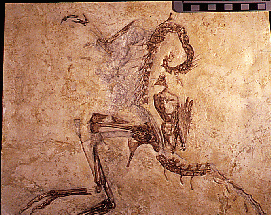The young coelurosaur, nicknamed "Eva," is closely related to iconic meat-eaters Tyrannosaurus rex and Velociraptor.
腔腸龍的主要群體
極其鳥類的獸腳龍恐龍
腔腸龍
在Mesa西南博物館,Mesa,AZ的Coelurosaur登上。照片©Geb Bennett。
警告:您正在進入一個不斷變化的分類研究領域。這一組的潛伏期的系統發育由涉及其研究的古生物學家辯論,並且新的分類被建議每年幾次!我們將嘗試保持這個網站更新,但現在,當你謹慎地操縱這個劇情展覽的陰影道路,記住,這個不同的組的關係尚未完全理解。這是一個令人沮喪和令人興奮的研究領域。所以仔細從這裡踏上...,看著陰影!飢餓的野獸潛伏在前面!
當前的聯合王國分類
Compsognathus
其中一個UCMP的Compsognathus的演員,從Solnhofen石灰石
龍舌蘭被定義為包含與鳥類更緊密相關的所有獸腳類的分支,而不是與龍族。肺結石的一些診斷特徵包括細長的臂和良好發展的鉸鏈樣踝(腳踝的可能旋轉減少,這在運動期間是有幫助的)。這些特徵可能會丟失或由後來的龍舌蘭(例如鳥)修改。
所有的連鎖龍都顯示出與鳥的大量形態學相似性,但是不同的連環體缺乏不同的鳥類特徵,因此這使得解決該組的系統發育的問題變得複雜。
這個問題的兩個例子是非常鳥狀的Compsognathus longipes(如右圖所示)和Ornitholestes hermanni,從好的標本已知的小的獸腳類,但是他們的系統發育親和力還沒有很好地解決,因為他們共享一些特徵,可能會密切聯合與一個組,但是然後缺少一些被認為是該組的診斷的功能。在這一點上,它們被認為是雪ae;換句話說,我們知道它們是獸腳類;和可能的coelurosaurs;但我們不知道他們是誰相關或如何適應大蜘蛛系統發育的大圖片。
主要腔腸龍類:
Maniraptora:易威猛,鳥類和其他腔腸龍類
Ornithomimidae:鳥模仿coelurosaurs
暴龍:巨型龍捲龍
http://www.ucmp.berkeley.edu/diapsids/saurischia/coelurosauria.html
The Major Groups of CoelurosaursExtremely bird-like theropod dinosaurs | ||||
Current coelurosaur classification
All coelurosaurs show a great number of morphological similarities with birds, but different coelurosaurs lack different bird-like characteristics, so this complicates the matter of resolving the phylogeny of the group. Two examples of this problem are the very bird-like Compsognathus longipes (shown at right) and Ornitholestes hermanni, small theropods known from good specimens, but whose phylogenetic affinities have not been well resolved yet, because they share some features that might closely unite them with a group, but then lack some features that are considered diagnostic for that group. At this point they are considered incertae sedis;in other words, we know that they are theropods; and probably coelurosaurs; but we don't know who they are related to or how they fit into the big picture of theropod phylogeny.
Major coelurosaurian groups:
Maniraptora: Velociraptor, birds, and other coelurosaurs
Ornithomimidae: The bird-mimic coelurosaurs Tyrannosauridae: The giant coelurosaurs |





沒有留言:
張貼留言